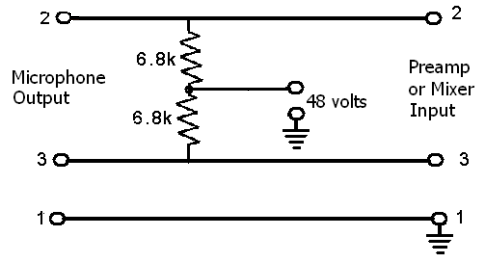Phantom Powered Microphones
If you've ever done anything on the professional side of audio, you've probably run into a condenser microphone. These require power to work. Sometimes, that's a battery you put into the mic. Sometimes it's a separate dedicated power supply with a special multi-pin cable.
But most often these microphones use phantom power. This is power delivered by a mixer or console, which uses the same cable that the audio comes back on. Hence, the idea phantom because the cable is doing two things and the power seems to be delivered by magic.
Phantom power is set up to run on shielded balanced lines, because it uses both the twisted pair and the shield as the DC power delivery. Unbalanced microphones, therefore, cannot use this system - at least not as it is described below.
Phantom powering is an idea as old as the telephone. In your telephone, on the two wires used you have DC to power the equipment, audio travelling in both directions, called duplex mode, so both people can talk at the same time, and 90 volts AC which actuates the ringer, all on one pair of wires! Phantom power is much simpler than that. The schematic below, gives you the basic idea of how it is wired up.

Pin 1 is ground, the shield connection in the cable. Pins 2 and 3 are the balanced line. You can see that the +48 volts is divided equally between both wires in the balanced line. If you took a voltmeter and read between pins 2 and 3, it would say ZERO volts. It's only when you look at those wires, compared to the ground/shield wire, that you would see +48 volts.
If your preamp or mixer has a real wound transformer input, and there is a transformer inside the microphone, these would effectively block the DC from entering the microphone element or the mixer circuitry. The voltage could easily be removed before then to power up whatever circuitry is inside the microphone. The power supply and circuitry above could easily be built into the console or mixer.
Of course, those two resistors have to be very precise, 1% tolerance or even better would be preferred. If you used a garden variety resistor with 10% or 20% tolerance, then those two resistors would not be the same and you could easily read a small voltage between pins 2 and 3. Even worse, this imbalance would affect the ability of this balanced line to reject noise. Those two wires need to be identical in every way to effectively get rid of common mode noise rejection. I feel another blog coming on!! The 6.8 kilo ohm value is for +48 volts. And the supply needs to be ultra-low low ripple noise so it doesn't introduce any stray noise signals.
Many phantom powered microphones these days will accept anything between 12 volts and +48 volts. A voltage regulator can easily accept a wide range of voltages and give you a single voltage output. In mics or mixers that do not use active balancing transformers you can accomplish the same phantom powering with the use of blocking capacitors and diodes. Just be sure that the resulting voltage between pin 2 and 3 is always zero. And you can see why cable such as Belden 1353A, which is a single unshielded bonded pair for analog or digital audio, won't work for phantom powered microphones. No shield!
In my past blog, we calculated the voltage drop on a pair of wires. But, in this case, because the actual wire gage could vary widely with the choice of microphone cable, it is hard to predict how far you could go. If your console supplies +48 volts, and your mic only needs +12 volts, then there could be a very significant voltage drop before you would even notice. I have seen phantom power working perfectly for hundreds of feet.
I still keep reading about microphones that don't need phantom power but don't play well with a line which has phantom power applied. This is why many consoles or mixers allow you to turn the phantom voltage on or off for each input. I hear this especially often about ribbon microphones. Is this just bad phantom powering or stray voltages biasing the elements inside the microphone? Email me with your stories of phantom power gone bad and I will share them here.
![System.String[]](https://assets.belden.com/transform/03fc9f76-3aac-4627-9fbd-756f31cab5bc/steve-lampen?io=transform:fill,width:300,height:300)